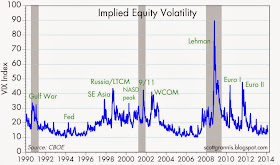A review of key market-based indicators shows that systemic risk is quite low, liquidity is abundant, and the economic outlook is reasonably healthy. This should inspire investors to take on more risk, and it makes a compelling case for the tapering and eventual reversal of the Fed's QE bond purchases.
Bloomberg has put together a comprehensive, real-time index of market-based indicators that measures liquidity, credit risk, default risk, systemic risk, and implied volatility (see chart above). Today, the index is very close to its all-time high—things just don't get much better. Note that the index deteriorated in advance of the last two recessions. Its current strength thus implies that the economy is virtually certain to continue to expand.
The charts that follow focus on a few of the indicators captured in the Bloomberg index shown above.
Swap spreads in the U.S. are about as low as they have ever been. Conditions in the Eurozone are not quite as healthy, but they have improved significantly in the past two years. Eurozone 2-yr swap spreads are not too far above the 20-30 bps range that would be considered "normal" or "healthy."
The first of the above two charts shows 5-yr credit default swap spreads for investment grade and high-yield (junk) bonds. The second shows the difference between the two, which isolates the extra spread demanded by investors to accept the additional risk of junk bonds. Both show that credit spreads are at or near their lowest levels of the current business cycle expansion, and only marginally higher than they were one year before that Great Recession hit.
This chart shows a longer-term view of the spreads on corporate bonds. It's the same message as CDS spreads: credit/default risk today is perceived by the market to be only marginally higher than it was during prior periods of healthy economic growth. Importantly, spreads continue to decline on the margin, suggesting improving economic conditions lie ahead.
The Vix index of implied volatility is currently trading in a "normal" range. There are no significant sources of concerns in today's market: the Eurozone is doing better, China is still growing, the federal budget deficit has shrunk dramatically, the Fed has tapered and the sky has not fallen, and corporate profits remain very strong.
A contrarian might worry that this reflects complacency and that itself is a concern. It's always possible that some new fear-inducing event will pop up around the corner, but in the absence of major sources of risk it is likely that the prices of risk assets will continue to move higher. Especially since the return on safe-haven cash and cash equivalents is very close to zero.







I advise investors to remain risk averse given the severe economic depression that is ensuing along Main Street USA as evidenced by long-term (10-year plus) declines in real working wages, real home values, and the employment to population ratio -- taking on risk in this environment is insanity -- stick with only high quality equities that pay regular dividends and rents -- avoid taking growth risk no matter what -- the news is horrifically bad along Main Street and the very thought of taking on more risk in this environment does not pass the laugh test.
ReplyDeleteThis comment has been removed by the author.
ReplyDeleteOT for Scott Grannis:
ReplyDeleteTED spreads are widening in China. China is th world's largest import of commodities, and major player all over Asia.
Views?